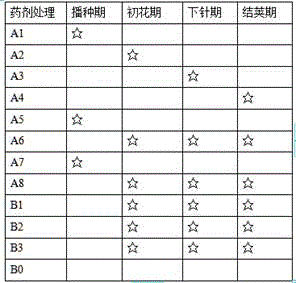Compound pesticide for plantation of peanuts and preparation method thereof
A compound pesticide and peanut planting technology, applied in the field of pesticides, can solve the problems of slow development and utilization of botanical pesticides, low activity of botanical pesticides, unfavorable pest control and other problems, and achieve improved disease resistance, good slow-release effect, and control Excellent effect
- Summary
- Abstract
- Description
- Claims
- Application Information
AI Technical Summary
Problems solved by technology
Method used
Image
Examples
Embodiment 1
[0027] Example 1: A compound pesticide for peanut planting, prepared from the following raw materials in parts by weight: 35 parts of poultry manure, 15 parts of peanut bran, 15 parts of pepper straw, 10 parts of pine needle powder, and 7 parts of lignocellulose , 6 parts of nitrogen, phosphorus and potassium compound fertilizers, and 7 parts of Chinese medicine compositions. 12 parts of Zanthoxylum bungeanum, 12 parts of cat's eye grass, 12 parts of catalpa leaves, 10 parts of nard pine, 7 parts of vitex leaves, and 7 parts of Euphorbia.
[0028] In the present invention, the weight ratio of nitrogen, phosphorus and potassium in the NPK compound fertilizer is 1-3:0.5-1.2:0.3-1.
[0029] In this embodiment, the weight ratio of nitrogen, phosphorus and potassium in the NPK compound fertilizer is 2:0.8:0.5.
[0030] The traditional Chinese medicine composition described in this embodiment is obtained by the following preparation method, specifically comprising the following ste...
Embodiment 2
[0044] Example 2: A compound pesticide for peanut planting, prepared from the following raw materials in parts by weight: 30 parts of poultry manure, 12 parts of peanut bran, 12 parts of pepper straw, 8 parts of pine needle powder, and 6 parts of lignocellulose , 5 parts of nitrogen, phosphorus and potassium compound fertilizers, and 6 parts of traditional Chinese medicine compositions. 10 parts of Zanthoxylum bungeanum, 10 parts of cat's eye grass, 10 parts of catalpa leaves, 8 parts of nard pine, 6 parts of vitex leaves, and 6 parts of euphorbia. In this embodiment, the weight ratio of nitrogen, phosphorus and potassium in the NPK compound fertilizer is 1:0.5:0.3.
[0045] The traditional Chinese medicine composition described in this embodiment is obtained by the following preparation method, specifically comprising the following steps:
[0046] 1) Take the bamboo leaf pepper, wild spinach, Zanthoxylum bungeanum, and cat's-eye grass in the above weight parts, mix them, and...
Embodiment 3
[0058] Example 3: A compound pesticide for peanut planting, prepared from the following raw materials in parts by weight: 32 parts of poultry manure, 18 parts of peanut bran, 18 parts of pepper straw, 12 parts of pine needle powder, and 8 parts of lignocellulose , 7 parts of nitrogen, phosphorus and potassium compound fertilizers, and 8 parts of traditional Chinese medicine compositions. 15 parts of Zanthoxylum bungeanum, 15 parts of cat's eye grass, 15 parts of catalpa leaves, 12 parts of nard pine, 8 parts of vitex leaves, and 8 parts of Euphorbia. In this embodiment, the weight ratio of nitrogen, phosphorus and potassium in the NPK compound fertilizer is 3:1.2:1.
[0059] The traditional Chinese medicine composition described in this embodiment is obtained by the following preparation method, specifically comprising the following steps:
[0060] 1) Weigh the bamboo leaf pepper and wild spinach in the above parts by weight, mix them, and crush them to obtain the crushed mat...
PUM
 Login to View More
Login to View More Abstract
Description
Claims
Application Information
 Login to View More
Login to View More - R&D
- Intellectual Property
- Life Sciences
- Materials
- Tech Scout
- Unparalleled Data Quality
- Higher Quality Content
- 60% Fewer Hallucinations
Browse by: Latest US Patents, China's latest patents, Technical Efficacy Thesaurus, Application Domain, Technology Topic, Popular Technical Reports.
© 2025 PatSnap. All rights reserved.Legal|Privacy policy|Modern Slavery Act Transparency Statement|Sitemap|About US| Contact US: help@patsnap.com



